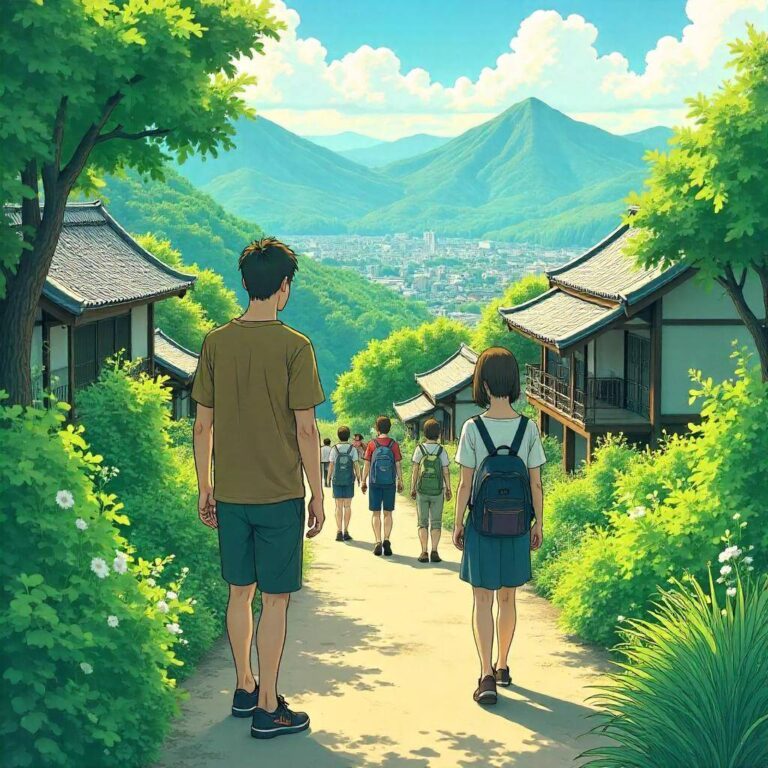Exploring the Magic of Japan: Beyond the Mouse Ears
Japan has long been a dream destination, often romanticized in movies, literature, and travel brochures. While many international visitors flock to the glitz of Tokyo Disneyland and the nostalgic charm of
the original Disneyland in California, this guide aims to steer you toward the authentic essence of Japan, away from the mainstream attractions and into the heart of its culture, nature, and hidden gems. In this comprehensive travel guide, you will find valuable insights on practical logistics, cultural nuances, insider tips, and everything you need to know to plan an unforgettable trip to Japan. —
Practical Logistics: Getting Around Japan
Transportation Options
Japan boasts one of the most efficient and reliable transportation systems in the world. Here’s how to navigate through the Land of the Rising Sun: 1. Japan Rail Pass – Overview: If you plan on traveling between multiple cities (Tokyo, Kyoto, Osaka, etc.), the Japan Rail Pass is a cost-effective choice. Available for 7, 14, or 21 days, it offers unlimited travel on most JR trains, including the famous Shinkansen (bullet trains). – Cost: Approximately ¥29,650 (around $280) for a standard 7-day pass. 2. Local Transportation – Subways and Buses: Each city has its own extensive subway and bus network. In Tokyo, for instance, the Toei and Tokyo Metro lines cover the city efficiently. Fares typically range from ¥170 to ¥320 ($1.50-$3). – IC Cards: Purchase a Suica or Pasmo card for easy travel on trains and buses. They can be topped up and are valid in many regions across Japan. 3. Taxis and Rideshares – While convenient, taxis can be expensive, especially in urban areas. Average starting fare is around ¥410 ($3.70). Uber operates in select areas but tends to be pricier than traditional taxis.
Accessibility Options
Japan is increasingly becoming more accessible to travelers with disabilities. Most major train stations have elevators, and many buses are equipped with ramps. However, some smaller stations and rural areas may lack these amenities. Always check accessibility features for individual attractions and facilities beforehand. —
Cultural Insights: Understanding Japan
Etiquette and Social Norms
Understanding and respecting local customs can enhance your travel experience. Here are some essential cultural tips: 1. Greetings – Bowing is the traditional form of greeting. However, a simple handshake is also acceptable, especially in business contexts. 2. Dining Etiquette – Always say “itadakimasu” before your meal and “gochisousama” after. Avoid sticking chopsticks upright in rice, as this symbolically represents funerals. 3. Public Behavior – Maintain a low noise level in public spaces. Speaking on mobile phones while on public transport is frowned upon.
Festivals and Traditions
Japan is rich in festivals that offer a glimpse into its vibrant culture. Some major festivals include: – Hanami (Cherry Blossom Viewing): Late March to early April – Experience picnics under blooming cherry trees. – Gion Matsuri: Held in July in Kyoto, this festival features elaborate floats and traditional performances. Being part of these festivities can deepen your appreciation for Japanese culture. —
Insider Tips: Hidden Gems and Local Secrets
Off-the-Beaten-Path Destinations
While the major cities are undoubtedly fascinating, some hidden gems provide a more authentic experience: 1. Naoshima Island – Known for its contemporary art museums and installations, Naoshima is a serene escape from the bustling cities. The island is home to the famous Yayoi Kusama’s Pumpkin sculpture. 2. Takayama – Nestled in the Japanese Alps, Takayama retains its traditional wooden buildings and streets. Visit the morning markets for local crafts and delicacies. 3. Shikoku Pilgrimage – This pilgrimage features 88 temples spread across the island and offers a unique hiking experience filled with spirituality and stunning landscapes.
Local Cuisine to Try
Japan is a food lover’s paradise. Here are some local dishes you can’t miss: – Okonomiyaki: A savory pancake filled with various ingredients, particularly popular in Osaka. – Hida Beef: Renowned for its marbling and tenderness, this beef is best enjoyed as sashimi or grilled. – Soba and Udon: These traditional noodles are perfect for a warming meal any time of the year. —
Budget Considerations: Managing Your Expenses
Traveling in Japan can be expensive, but with some planning, you can manage your budget effectively.
Cost Breakdown – Accommodations: Ranges from budget hostels (¥2,500-¥6,000/$25-$55 per night) to luxury hotels (¥20,000+/$180+ per night). – Food: A meal at a casual restaurant might cost ¥1,000-¥2,500 ($9-$23), while fine dining can go upwards of ¥10,000 ($90). – Attractions: Entrance fees for temples and museums typically range from ¥500-¥2,000 ($5-$18).
Tips for Saving – Eat like a local: Convenience stores (konbini) offer affordable and delicious meal options. – Free Attractions: Many parks and shrines are free to visit, providing ample opportunities to experience nature and culture without spending money. – Plan Your Trip in Off-Peak Seasons: Traveling during Japan’s shoulder seasons (April-May, September-November) can save you significantly on flights and accommodations. —
Timing Recommendations: When to Visit Japan
Best Seasons to Experience Japan – Spring (March to May): Famous for cherry blossoms; popular but can be crowded. – Summer (June to August): Hot and humid, yet vibrant with festivals. – Autumn (September to November): Stunning fall foliage and comfortable temperatures; ideal for hiking. – Winter (December to February): Great for skiing in regions like Hokkaido but can be cold.
Common Mistakes to Avoid 1. Not Planning Ahead: Popular attractions can sell out quickly, so book your accommodations and transportation in advance. 2. Ignoring Local Customs: Be mindful of cultural norms, as failing to do so can be viewed as disrespectful. 3. Overpacking: Japan has an efficient laundry system, and convenience stores provide essential items, so pack light. —
Step-by-Step Planning Advice
1. Define Your Itinerary – Start by identifying the cities and regions you want to visit. A common route includes Tokyo, Kyoto, and Osaka, but consider adding other cities like Hiroshima or Sapporo.
2. Secure Accommodations – Research your lodging options. For a more authentic experience, consider ryokan (traditional inns) or guesthouses.
3. Travel Arrangements – Book your Japan Rail Pass online in advance and reserve seats on popular Shinkansen routes.
4. Explore Cultural Experiences – Look for local workshops, such as tea ceremonies or pottery classes, to immerse yourself in Japanese culture.
5. Pack Accordingly – Bring lightweight clothes for summer or warm layers for winter, and don’t forget comfortable walking shoes! —
Conclusion: Discovering the True Spirit of Japan
Timing Recommendations: When to Visit Japan
Best Seasons to Experience Japan – Spring (March to May): Famous for cherry blossoms; popular but can be crowded. – Summer (June to August): Hot and humid, yet vibrant with festivals. – Autumn (September to November): Stunning fall foliage and comfortable temperatures; ideal for hiking. – Winter (December to February): Great for skiing in regions like Hokkaido but can be cold.
Common Mistakes to Avoid 1. Not Planning Ahead: Popular attractions can sell out quickly, so book your accommodations and transportation in advance. 2. Ignoring Local Customs: Be mindful of cultural norms, as failing to do so can be viewed as disrespectful. 3. Overpacking: Japan has an efficient laundry system, and convenience stores provide essential items, so pack light. —
Step-by-Step Planning Advice
1. Define Your Itinerary – Start by identifying the cities and regions you want to visit. A common route includes Tokyo, Kyoto, and Osaka, but consider adding other cities like Hiroshima or Sapporo.
2. Secure Accommodations – Research your lodging options. For a more authentic experience, consider ryokan (traditional inns) or guesthouses.
3. Travel Arrangements – Book your Japan Rail Pass online in advance and reserve seats on popular Shinkansen routes.
4. Explore Cultural Experiences – Look for local workshops, such as tea ceremonies or pottery classes, to immerse yourself in Japanese culture.
5. Pack Accordingly – Bring lightweight clothes for summer or warm layers for winter, and don’t forget comfortable walking shoes! —
Conclusion: Discovering the True Spirit of Japan
Step-by-Step Planning Advice
1. Define Your Itinerary – Start by identifying the cities and regions you want to visit. A common route includes Tokyo, Kyoto, and Osaka, but consider adding other cities like Hiroshima or Sapporo.
2. Secure Accommodations – Research your lodging options. For a more authentic experience, consider ryokan (traditional inns) or guesthouses.
3. Travel Arrangements – Book your Japan Rail Pass online in advance and reserve seats on popular Shinkansen routes.
4. Explore Cultural Experiences – Look for local workshops, such as tea ceremonies or pottery classes, to immerse yourself in Japanese culture.
5. Pack Accordingly – Bring lightweight clothes for summer or warm layers for winter, and don’t forget comfortable walking shoes! —
Conclusion: Discovering the True Spirit of Japan
3. Travel Arrangements – Book your Japan Rail Pass online in advance and reserve seats on popular Shinkansen routes.
4. Explore Cultural Experiences – Look for local workshops, such as tea ceremonies or pottery classes, to immerse yourself in Japanese culture.
5. Pack Accordingly – Bring lightweight clothes for summer or warm layers for winter, and don’t forget comfortable walking shoes! —
Conclusion: Discovering the True Spirit of Japan
5. Pack Accordingly – Bring lightweight clothes for summer or warm layers for winter, and don’t forget comfortable walking shoes! —
Conclusion: Discovering the True Spirit of Japan
Japan is a country that beautifully balances tradition and modernity, with endless opportunities for exploration. While theme parks and commercial attractions have their allure, the true magic of Japan lies in its heritage, natural beauty, and the warmth of its people. By venturing off the beaten path, respecting local customs, and engaging with the culture, you will uncover the depths of Japan’s charm and create memories that go beyond mere tourism. Whether it’s savoring street food at a night market, soaking in an onsen, or observing a traditional tea ceremony, Japan is waiting to share its wonders with you. Embrace the journey, and let Japan enchant you with its unparalleled beauty and rich tapestry of experiences. Happy travels!



